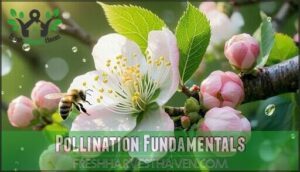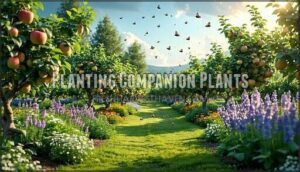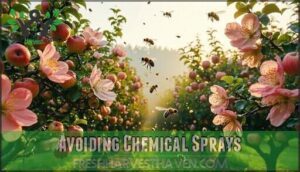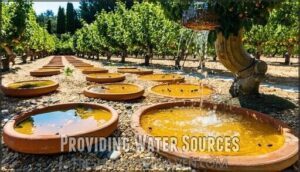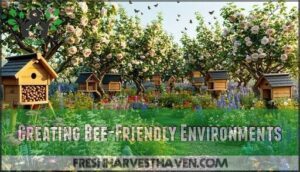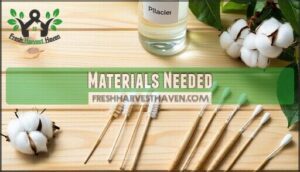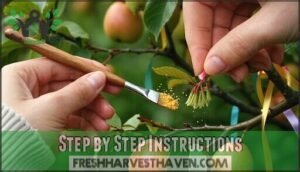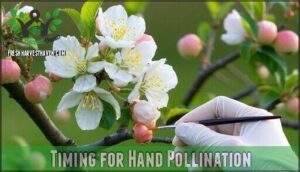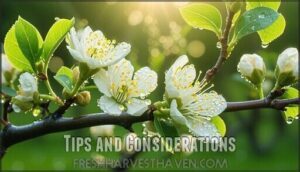This site is supported by our readers. We may earn a commission, at no cost to you, if you purchase through links.
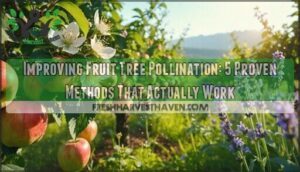 You can boost fruit production by improving fruit tree pollination through strategic planning and natural methods.
You can boost fruit production by improving fruit tree pollination through strategic planning and natural methods.
Plant compatible varieties within 100 feet of each other, since most fruit trees need cross-pollination.
Create pollinator-friendly environments by adding native flowering plants nearby and avoiding pesticides during bloom time.
Hand-pollinate using a small brush when natural pollinators are scarce—simply transfer pollen between flowers on calm, dry days.
Maintain healthy bee populations by providing water sources and nesting sites.
Time your efforts with peak bloom periods for maximum effectiveness.
These proven techniques can dramatically increase your harvest, but there’s more to master about timing, technique, and troubleshooting common pollination problems.
Table Of Contents
- Key Takeaways
- Fruit Tree Selection Basics
- Pollination Fundamentals
- Enhancing Pollinator Habitats
- Hand Pollination Techniques
- Optimizing Pollination Conditions
- Frequently Asked Questions (FAQs)
- How to increase pollination of fruit trees?
- What does baking soda do for fruit trees?
- How to fix poor pollination?
- How to encourage fruit trees to flower?
- How to help fruit trees pollinate?
- How can we fix poor pollination?
- What increases the chance of pollination?
- How do you increase cross-pollination?
- When should I prune trees for pollination?
- How does soil pH affect pollination success?
- Conclusion
Key Takeaways
- Plant compatible varieties within 100 feet – Most fruit trees need cross-pollination partners nearby, and strategic placement can boost your harvest by ensuring proper pollen transfer between different varieties of the same species.
- Create pollinator-friendly environments – You’ll attract more bees by planting native flowering plants around your orchard, providing water sources, and avoiding pesticides during bloom time to maintain healthy pollinator populations.
- Use hand-pollination as a backup – When natural pollinators aren’t available, you can transfer pollen between flowers using a small brush during early morning hours when stigmas are most receptive.
- Time your efforts with bloom periods – You’ll maximize pollination success by monitoring weather conditions (65-75°F is ideal), ensuring proper soil moisture, and coordinating activities with peak flowering times across your different tree varieties.
Fruit Tree Selection Basics
Before you can improve pollination, you need to select the right trees for your specific growing conditions and space constraints.
Your success starts with matching tree varieties to your climate zone, soil type, and available sunlight while considering factors like mature tree size and pollination requirements.
Climate Considerations
Your regional climate dictates which fruit trees will thrive and produce abundant harvests.
Temperature fluctuations and seasonal shifts affect bloom timing, making cross pollination strategies essential for success.
Cold snaps can devastate blossoms, while excessive heat stresses trees.
Weather patterns influence pollination techniques you’ll need.
Consider microclimates within your property—sheltered spots may extend growing seasons for temperature-sensitive varieties.
Understanding the importance of hardiness zones is vital for selecting the right fruit trees for your specific climate.
Soil Type and Sunlight Requirements
Before planting fruit trees, you’ll want to test your soil pH—most trees thrive between 6.0-7.0.
Well-draining soil prevents root rot while supporting healthy tree growth.
Your trees need 6-8 sunlight hours daily for ideal fruit yield.
Poor soil drainage kills more trees than drought does.
These foundational elements directly impact your fruit tree pollination success and overall tree pollination methods effectiveness, which relies on healthy tree growth.
Choosing Dwarf Varieties
Many gardeners overlook dwarf varieties when planning their fruit orchards, yet these compact powerhouses deliver impressive fruit yield while requiring minimal space.
Dwarf selection offers significant advantages for container growing and small yards, with mature tree size reaching only 6-8 feet.
These space saving options maintain excellent fruit production and tree health while allowing closer pollinator access between varieties, ultimately improving fruit tree pollination success rates.
Researching Specific Tree Varieties
Research drives successful fruit tree selection. You can’t just pick any variety and hope for the best.
Understanding pollen compatibility, climate tolerance, and soil adaptation requirements saves years of disappointment. Smart growers check regional performance data before planting.
- Verify pollination requirements – Some varieties need cross-pollination partners within 50 feet for maximum fruit yield
- Match climate zones – Cold-hardy apples won’t thrive in citrus-growing regions, regardless of care
- Check soil preferences – Stone fruits prefer well-draining soil while some varieties tolerate clay better
Pollination Fundamentals
Understanding pollination basics transforms your fruit tree care from guesswork into science-backed success. You’ll need this foundation before implementing any of the five proven methods that follow.
What is Pollination
Pollination is nature’s matchmaking service for your fruit trees.
This essential pollination process involves moving pollen from flower stamens to the stigma, enabling fruit production.
Successful pollen transfer depends on flower biology timing and pollinator roles.
Cross pollination between compatible varieties often yields better harvests than self-pollination.
Understanding bee pollination and maintaining pollinator health guarantees reliable pollination services for improving fruit tree pollination success.
Effective fruit tree care requires knowledge of pollination techniques to maximize harvests.
Types of Pollination
Fruit trees reproduce through three primary methods.
Self Pollination occurs when a tree’s flowers fertilize using their own pollen, perfect for single-tree gardens.
Cross Pollination requires pollen transfer between different varieties of the same species, typically producing superior fruit.
Wind Pollination and insect pollination naturally move pollen, while artificial pollination involves human intervention when natural pollinator health is compromised.
- Self Pollination: Apricots, peaches, and citrus trees can fertilize themselves, making them ideal for small spaces where planting multiple varieties isn’t practical
- Cross Pollination: Most apple and pear varieties need compatible partners within 100 feet to produce fruit, often resulting in larger harvests and better quality
- Artificial Pollination: Hand-pollination techniques become necessary when bee pollination services are insufficient or when improving fruit tree pollination in controlled environments.
For best results, consider exploring self pollinating options to enhance your garden’s productivity.
Importance of Pollinators
Your fruit trees depend on nature’s workforce to transform blossoms into harvest.
Bee pollination drives fruit yield through efficient pollen transfer, while pollinator diversity strengthens ecosystem health.
Over forty wild bee species outperform honey bees in pollination services, with mining bees transferring 2.5 times more pollen.
Nature’s elite: wild mining bees outwork honeybees, delivering 2.5x more pollen per visit.
Supporting bee conservation and planting pollinator friendly plants creates sustainable fruit production systems.
Environmental Factors Affecting Pollination
Weather patterns dictate your fruit tree’s pollination success more than you might realize.
Temperature effects can shut down bee activity below 50°F, while excessive heat above 85°F reduces pollen viability.
Soil moisture levels directly impact flower quality, and strong wind patterns scatter pollinators away from blossoms.
Climate change increasingly disrupts traditional bloom timing, making orchard management more challenging for maintaining consistent pollination efficiency.
Enhancing Pollinator Habitats
Creating the right environment around your fruit trees can double or triple your pollination success.
You’ll transform your orchard into a buzzing hub of activity by establishing habitats that attract and support the wild bees, beneficial insects, and other pollinators your trees desperately need to produce abundant fruit.
Planting Companion Plants
Strategic companion planting transforms your orchard into a pollinator paradise.
Guild planting with borage, clover, and lavender creates biodiverse gardens that boost bee visits by 40%.
These companion flowers provide continuous nectar sources while enriching soil through nitrogen fixation.
Tree guilds with pollinator plants increase fruit yield by 32% through enhanced pollination services, creating thriving ecosystems around your trees.
Effective plant guild designs are essential for maximizing the benefits of companion planting in orchards.
Avoiding Chemical Sprays
Chemical sprays can devastate your orchard’s pollinator populations, turning productive trees into barren showpieces.
Smart growers protect these essential workers by choosing organic methods and eco-friendly alternatives that maintain pollinator-friendly habitats.
- Apply organic pesticides only after petal fall – avoiding pollinator exposure during critical bloom periods
- Use natural fungicides like neem oil – providing effective pest control without pesticide toxicity
- Time soil remediation treatments – scheduling applications when pollinators aren’t actively foraging
- Choose biological controls over chemicals – introducing beneficial insects that won’t harm bee populations
- Monitor weather conditions before spraying – ensuring treatments don’t coincide with peak pollination and fertilization activities
Providing Water Sources
Thirsty pollinators need reliable water sources just like your fruit trees need irrigation systems. You’ll boost pollination services by providing shallow water dishes, drip irrigation systems that create puddles, or small fountains near your orchard.
Consistent soil moisture from proper water conservation methods attracts more pollinators to support fruit tree production. Effective pollinator gardening techniques can also enhance the overall health of your orchard by creating a welcoming environment for various pollinator species.
| Water Source Type | Setup Requirements | Pollinator Benefits | Maintenance Level |
|---|---|---|---|
| Shallow dishes | Rocks, clean water | Easy bee access | Daily refilling |
| Drip systems | Timers, emitters | Steady moisture | Weekly checks |
| Small fountains | Power, pump setup | Movement attracts | Monthly cleaning |
| Mud puddles | Clay soil, irrigation | Mineral access | Seasonal refresh |
The use of proper water conservation methods and effective gardening techniques can significantly improve the health and productivity of your orchard, making it an ideal location for various pollinator species to thrive. By providing the necessary water sources and maintaining a welcoming environment, you can boost pollination services and support the overall well-being of your fruit trees.
Creating Bee-Friendly Environments
Buzz around your orchard by designing spaces that welcome bee families year-round. Creating pollinator-friendly habitats requires strategic habitat creation that supports diverse bee nutrition needs.
- Install bee hotels near fruit trees to house solitary pollinators
- Plant floral diversity with native species for extended blooming seasons
- Establish pollinator gardens featuring continuous flower succession
- Maintain undisturbed ground areas for ground-nesting bee-friendly habitats
- Preserve dead wood and stems for cavity-nesting fruit tree pollinators
Hand Pollination Techniques
When natural pollinators aren’t available or you need to boost fruit production, hand pollination becomes your most reliable backup plan.
This technique puts you in complete control of the pollination process, ensuring your fruit trees get the pollen transfer they need to produce a healthy harvest.
Materials Needed
Hand pollination requires simple tools you can find at home. Grab soft-bristled pollen brushes or cotton swabs as your primary pollen collectors.
These cotton tools gently transfer pollen without damaging delicate flower parts. You’ll also need label markers to track which flowers you’ve pollinated.
Keep rubbing alcohol handy to sanitize tools between different tree varieties, preventing cross-contamination that could affect your fruit tree pollinators’ natural work.
For effective pollination, understanding pollen brush techniques is essential for maximizing fruit production.
Step by Step Instructions
Gently brush pollen-covered anthers to collect golden dust on your tool.
Transfer this treasure to the sticky stigma using small circular motions.
Move systematically through each blossom, sanitizing tools between different tree varieties.
Mark completed flowers with colored ribbons for tracking success.
This pollination timing guarantees maximal fruit yield when natural pollinators aren’t available, which is a treasure.
Timing for Hand Pollination
Perfect bloom timing transforms your hand pollination success from hit-or-miss to reliable fruit production.
Watch for these critical windows when implementing pollination best practices:
- Peak receptivity occurs when stigmas appear moist and sticky, typically 2-3 days after flowers open
- Early morning sessions maximize pollen collection effectiveness before midday heat reduces viability
- Monitor bloom timing across compatible varieties to synchronize cross-pollination opportunities
- Stop at petal fall – this marks the end of viable pollination for ideal fruit set
Tips and Considerations
Successful hand pollination requires careful attention to specific timing and environmental factors.
You’ll want to verify whether your fruit tree species actually needs hand pollination, as some varieties like figs and citrus can self-pollinate effectively without intervention.
| Timing Factor | Optimal Condition | Why It Matters |
|---|---|---|
| Pollination Timing | Early morning (7-10 AM) | Fresh pollen availability, maximum flower receptivity |
| Weather | Dry, 65-75°F conditions | Prevents pollen washout, guarantees bee activity |
| Flower Stage | Yellow anthers, sticky stigmas | Maximum pollen viability for fruit set |
| Cross Pollination | Compatible varieties nearby | Increases genetic diversity, improves yield |
| Pollen Collection | Daily during bloom period | Maintains fresh supply for best results |
Remember to sanitize your tools between different tree varieties to prevent disease transmission and guarantee proper pollinator health practices throughout your orchard management routine.
Optimizing Pollination Conditions
Even with perfect trees and timing, you’ll still need to create the right conditions for successful pollination to occur.
Weather, bee management, and flower health all play critical roles in determining whether your fruit trees will produce a bountiful harvest.
Managing Bee Colonies
Strong colonies with healthy queens boost fruit production by 50% compared to relying on wild pollinators alone.
Colony management requires vigilant monitoring and strategic placement for maximum pollination success.
- Maintain 20,000+ active worker bees per colony during peak bloom for maximum pollination effectiveness
- Place 2-5 hives per hectare within 200 meters of fruit trees to maximize foraging rates
- Schedule annual queen replacement and Varroa mite treatments to prevent 42% foraging activity losses
- Provide supplemental feeding during early blossom phase to extend bee longevity by 21 days
- Monitor hive entrance traffic using electronic counters to track 8.3 daily foraging trips per worker
Effective colony management also involves using proper Bee Hive Boxes to support the health and productivity of the bees.
Colony management requires vigilant monitoring and strategic placement for ideal pollination success.
Ensuring Proper Weather Conditions
Weather conditions make or break pollination success. Monitor temperature closely – pollinators work best between 65°F and 75°F.
Install frost protection systems and wind shields around trees during bloom. Maintain proper soil moisture through climate monitoring.
Cold snaps below 50°F reduce pollinator activity substantially. Protect blossoms from harsh winds that scatter pollen and damage flowers, ensuring maximum sunlight reaches blooms for maximum fruit yield.
Understanding the importance of proper pollination techniques is vital for maximizing fruit production and tree health.
Minimizing Flower Drop
Flower drop prevention requires consistent moisture management and proper nutrition during the critical blooming window.
Water stress triggers premature blossom drop, while balanced fertilization supports healthy pollen viability and fruit set enhancement.
- Water deeply every 7-10 days during bloom period to maintain soil moisture
- Apply organic fertilizer in early spring before buds break
- Mulch around trees to retain moisture and regulate soil temperature
- Monitor weather forecasts and provide frost protection when needed
- Avoid heavy pruning during active blooming to reduce tree stress
Troubleshooting Pollination Issues
Poor fruit set often signals underlying pollination problems that require systematic diagnosis.
When trees bloom abundantly but produce minimal fruit, you’re likely facing pollination failure from inadequate bee health, environmental stress, or timing mismatches.
Flower drop during bloom indicates pollen quality issues or pest management problems affecting fertilization success.
| Problem | Cause | Solution |
|---|---|---|
| No fruit despite blooms | Missing pollinizer varieties | Plant compatible trees within 100 feet |
| Misshapen fruit | Incomplete pollination | Improve bee health through habitat enhancement |
| Early flower drop | Pest control timing issues | Avoid spraying during bloom periods |
| Low bee activity | Poor environmental conditions | Create pollinator conservation areas nearby |
These tree pollination tips help beginners establish effective pollination contracts with nature’s workforce.
Frequently Asked Questions (FAQs)
How to increase pollination of fruit trees?
Mining bees deposit 5 times more pollen than honey bees on apple flowers.
You’ll boost pollination by planting diverse flowering plants nearby, maintaining wild bee nesting sites, and ensuring proper tree spacing within 50 feet for cross-pollination success.
What does baking soda do for fruit trees?
Baking soda acts as a natural fungicide for your fruit trees, helping prevent powdery mildew and other fungal diseases.
You’ll mix it with water to create an effective, eco-friendly spray that protects leaves and improves overall tree health.
How to fix poor pollination?
Boost pollination by planting compatible varieties within fifty feet, encouraging native bees with flowering plants.
Hand-pollinating during bloom using small brushes, and timing pesticide applications after petal fall to protect pollinators.
How to encourage fruit trees to flower?
While some trees stubbornly refuse to bloom, others burst with blossoms through proper care.
You’ll encourage flowering by providing full sun exposure, applying balanced fertilizer in early spring, ensuring adequate winter chill hours, and maintaining consistent watering without overfeeding nitrogen, which is crucial for consistent watering.
How to help fruit trees pollinate?
Plant compatible varieties within 50 feet, encourage wild bees with diverse flowers, maintain honey bee colonies, and use hand pollination during bloom time for reliable fruit set.
How can we fix poor pollination?
Address pollination challenges by planting compatible varieties within 50 feet, encouraging native bees with flower strips, hand-pollinating during bloom, and avoiding pesticides when flowers are open.
What increases the chance of pollination?
Contrary to popular belief that more bees automatically mean better pollination, strategic placement matters most.
You’ll increase pollination success by planting compatible varieties within fifty feet, ensuring overlapping bloom times, and maintaining diverse wild bee habitats nearby.
How do you increase cross-pollination?
You’ll boost cross-pollination by planting compatible varieties within 50 feet, ensuring overlapping bloom times, and creating pollinator-friendly habitats with diverse flowering plants nearby.
When should I prune trees for pollination?
Like a skilled surgeon timing a delicate operation, you’ll prune fruit trees during winter dormancy to maximize next season’s pollination success.
Pruning opens tree centers, improving sunlight penetration and air circulation, which enhances flower development and attracts more pollinators for better fruit production.
How does soil pH affect pollination success?
Soil pH doesn’t directly impact pollination, but it affects tree health and flower quality.
You’ll get better blooms when pH stays between 0-0, supporting strong trees that attract more pollinators naturally.
Conclusion
Sarah’s apple orchard produced only half its expected yield until she implemented cross-pollination strategies and attracted more bees.
Improving fruit tree pollination requires combining multiple approaches for maximum success.
Plant compatible varieties within 100 feet, create pollinator-friendly environments with native flowers, and hand-pollinate when necessary.
Maintain bee populations through water sources and avoid pesticides during bloom periods.
With proper timing and technique, you’ll dramatically increase your harvest yields and enjoy more abundant fruit production seasons, resulting in a more abundant harvest.
- https://pmc.ncbi.nlm.nih.gov/articles/PMC3976118/
- https://myperfectplants.com/blogs/blog/pollination-in-fruit-trees
- https://decisionaid.systems/articles/Factors_Affecting_Bee_Pollination_of_Tree_Fruits
- https://extension.psu.edu/home-orchards-why-is-there-no-fruit-on-my-tree/
- https://www.sciencedirect.com/science/article/pii/S2468265922000166

